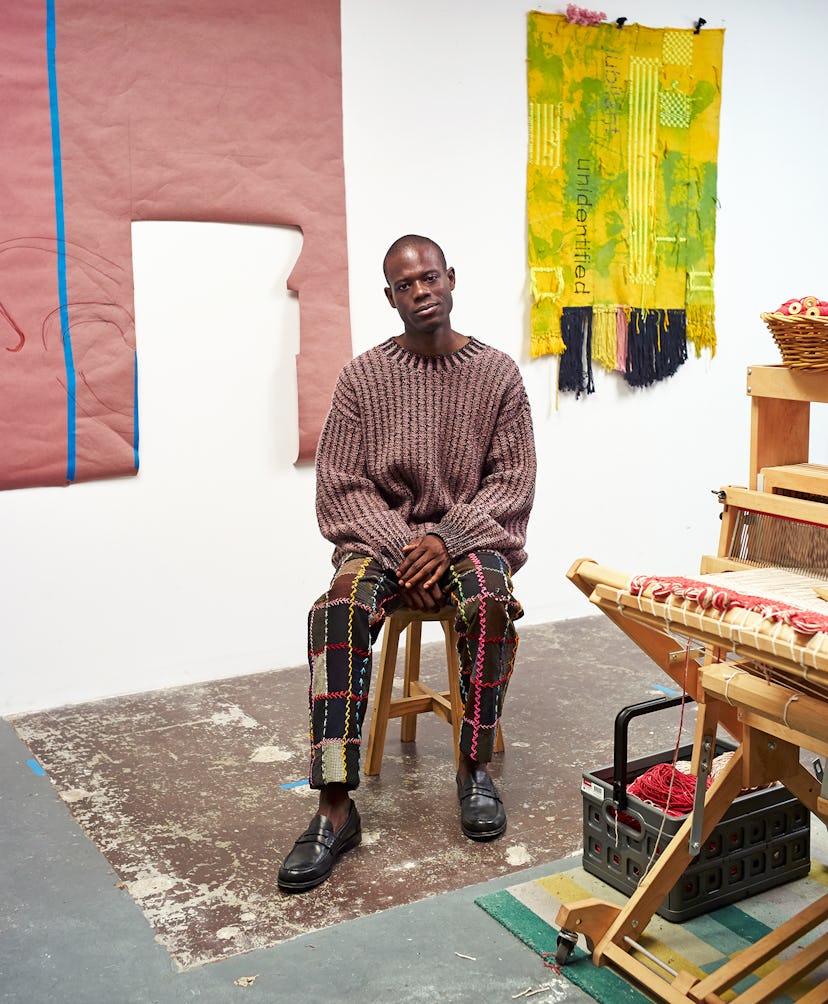Texan Artist Diedrick Brackens Weaves Black History Into His Tapestries

Lake Mexia is a short, hot drive from the small town of Mexia, Texas, where the artist Diedrick Brackens was born. In 1981, three black teenagers drowned there while in police custody. Apprehended for marijuana possession, they were being rowed across the lake when the boat capsized. All three teenagers died, but the police officers survived and were later acquitted of any wrongdoing.
The deaths occurred eight years before Brackens was born, but he heard different versions of the event “from every adult in town,” he says, and ultimately made an elliptical but powerful artwork out of the trauma: a golden tapestry that shows a pair of silhouetted black figures fishing with their hands, with three feisty catfish evoking the boys’ spirits living on in some fantastic way. Featured in the Hammer Museum’s Made in L.A. biennial in 2018 and at the New Museum, in New York, this past summer, it has become his most acclaimed work. It captures his feeling for textiles and textures, his fragmented and fantastic narratives, and his interest in the legacy of racial injustice. It also has an emotional current not often seen in contemporary art—a tenderness and vulnerability that leaves people feeling uneasy, reaching for clichés about his work being “poetic.”
Now Brackens, who is 30, has a new weaving hanging in his studio that touches on this narrative, while also evoking Barry Jenkins’s film Moonlight. The scene in If You Feed a River, which the New Orleans Museum of Art has acquired, has great tension: Two dark figures appear entangled with white ones in what could be a romantic or a violent interaction. The palette is darker: a slate black sky set off by a bright moon with catfish, again, swimming in the water below.
*Heaven Is a Muddy Riverbed*, 2018.
“I’ve been thinking about catfish for a while, relative to Southern identity and heritage—how much they’re in the landscape and food. They are seen as scavengers or bottom-feeders, the lowest form of fish you might eat, but I like the idea of elevating them to the level of tapestry. They’re my spirit animal,” says Brackens, from his small studio in the Leimert Park neighborhood of Los Angeles, where two looms take up most of the floor space and piles of weavings take up the rest. (He shares the studio building and house in front with the fiercely talented and also fast-track artist Genevieve Gaignard—“my best friend, my roommate, my everything,” he says of her.)
Brackens’s catfish offer a way of updating motifs from Renaissance tapestries, which generally feature more stately animals like horses or unicorns. But that’s far from his only historical reference, as he works to combine different cultural traditions, including the stripes associated with African weavings, especially kente cloth, and the improvised patterning of American crazy quilts. As the Hammer curator Erin Christovale puts it, “He’s speaking through this formal perspective about his identity as a black American.”
Brackens uses both commercial and natural dyes for his tapestries—Lipton black tea is a favorite. “It’s connected for me to being black, queer, and Southern. In Southern slang, ‘tea’ is another way to talk about gossip. ‘Come over, what’s the tea?’ ‘Spill the tea.’ ” His choice of cotton, too, is loaded, because of “its relationship to slavery—it being a king crop in the South and in Texas.” He remembers hearing older relatives talking about picking cotton: “They described the weight of sacks and the backbreaking work, or wrapping their hands so they’re not eaten up by the thorns of the boll. Now I get to do these beautiful things because I want to, not because I have to. It’s a way to honor that history,” he says.
*Bittersweet Attendance, Drown Jubilee,* 2018.
Brackens began weaving in college at the University of North Texas in Denton, when a professor suggested he take a textile course. He got his MFA in textiles in 2014 from the California College of the Arts, in San Francisco, then landed a job the following year running the fiber program at California State University, Long Beach, which brought him to Southern California. He stopped teaching this spring, after winning several cash awards, including one from the Studio Museum in Harlem. Jack Shainman Gallery, in New York, is giving him a show next spring.
Fiber artists tend not to get a lot of attention from the contemporary art cartel, but Brackens is proving an exception: He’s one of the few working today who makes the age-old craft seem relevant, even urgent. He draws, too, as preparation for his tapestries, but the loom is his tool and instrument for improvisation. “Weaving is where the invention is for me, where I do things on the fly,” he says. “As much as you’re acting on this machine, it’s acting on you too. But there’s so much room to coax out these emotive qualities and lines and gestures from these simple yarns.”